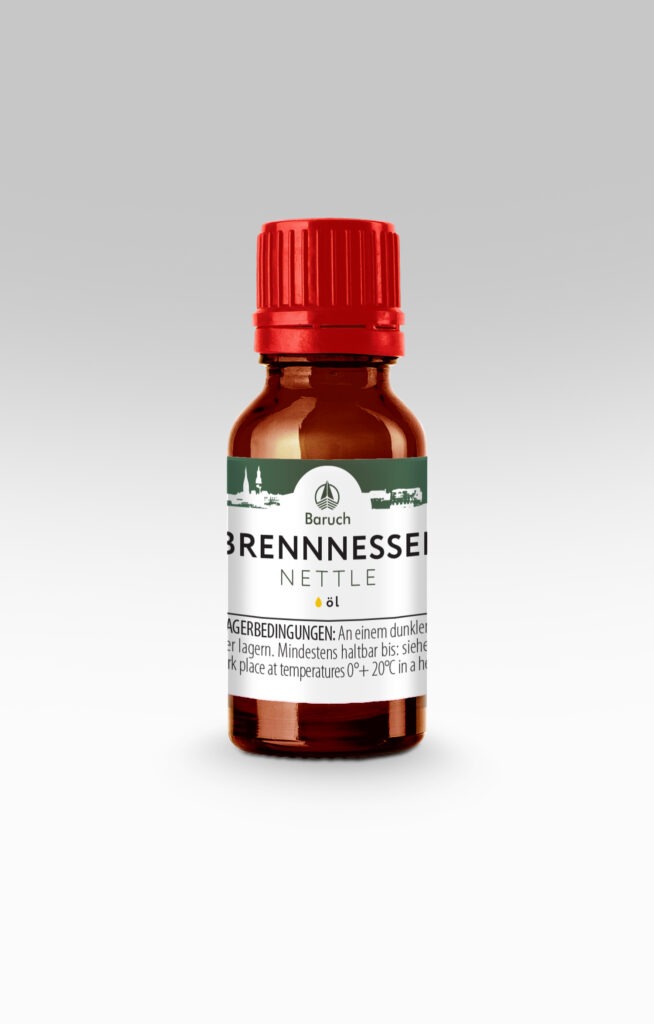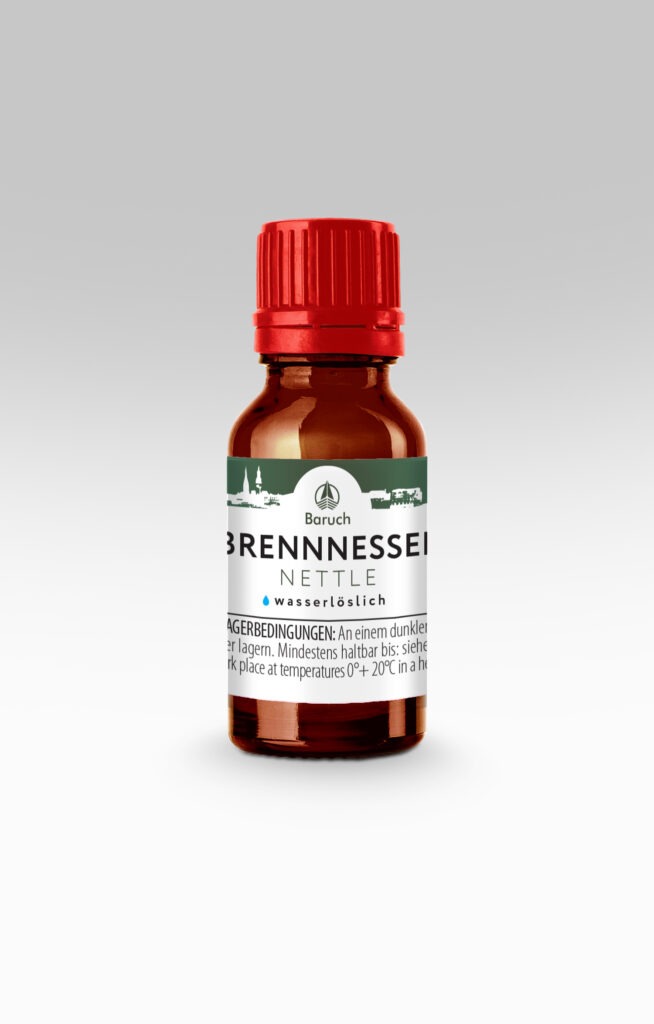CO2 extract is made from the leaves of nettles. There is common nettle, small nettle, reed nettle and Roman nettle. It is largely known simply as “stinging nettle”. This name comes from the fact that nettle leaves can burn the skin.
In folk and official medicine, fat-soluble extracts from nettle leaves, including CO2 extract, are used for bronchitis and pneumonia, as an expectorant, for bronchial asthma, pulmonary tuberculosis and as a preventive and therapeutic agent for iron deficiency anemia.
For the treatment of gastritis with impaired secretory function. For diseases of the musculoskeletal system, wounds and inflammation of the skin, for fractures and other injuries, for reduced immunity. For bleeding during and after childbirth and heavy menstruation. The extract contains a significant amount of vitamin K1 and K2, which are a combination of 2-methyl-1,4-naphthoquinone derivatives – menaquinone, menatetrichinone, phytomenadione, etc. In addition to the hemostatic effect, this vitamin is actively involved in the calcium metabolism and the synthesis of a number of extremely important proteins.
CO2 extract from the leaves of the nettle, like nettle oil, is typically not used in cooking. This is because, unlike fresh and even dry leaves, it does not contain the ascorbic acid, oxalic acid, sugar and other compounds that give foods the nettle flavor. However, it is the CO2 extract that is widely recommended as a biologically active substance in foods and beverages, giving them a number of useful properties that are particularly important in weight training. At the same time, very high concentrations of unique lipophilic compounds manifest themselves very quickly and effectively, but without harm to health, unlike synthetic drugs.
CO2 extract from nettle leaves is a light-yellow oily liquid with a weak specific aroma. The exact chemical composition of the CO2 extract from nettle leaves is not known.


Chart 1. Main components of nettle CO2 extract
| NAME | CONTENT IN% OF THE AMOUNT OF VOLATILE COMPONENTS | EFFECT |
|---|---|---|
| N-Nanocosan | 3,1 | Biological activity has not been investigated. |
| Dihydroactinidiolide | 2,1 | Antiseptic, heals ulcers and burns, tonic, anti-inflammatory. |
| Phytol | 2,1 | Has antimicrobial and anti-inflammatory, anti-aging, antioxidant, hemostatic effects. |
| Beta-carotene | 2 | Reduces sensitivity to light, helps wound healing. In the body it is converted into vitamins A1 and A2. A metabolic regulator, promotes the formation of epithelium, in the presence of vitamin E it is an active antioxidant. |
| Vitamin K1 | 0,2 | Regulates blood clotting. Has a wound healing effect, is used in the treatment of ulcers of the mucous membranes of internal organs. It helps improve and speed up the absorption of calcium by cells and tissues in the body. Neutralizes strong poisons and toxins that have a destructive effect on the cells of the internal organs (especially the liver). |
| Vitamin K2 | 0,2 | Stops internal bleeding, accelerates skin recovery, improves muscle tone. Normalizes calcium metabolism. Shows pronounced anti-cancer properties. |
In cosmetics, the oil solution of the nettle leaf CO2 extract is used as a highly effective substitute for the oil extract of the nettle leaves and for the production of a number of cosmetic creams and masks:
- for shiny and healthy looking hair;
- to accelerate hair growth and density;
- in anti-aging creams and masks for the skin of the face;
- in creams to maintain the firmness and elasticity of the skin;
- in products to fight acne;
- in products to combat fine wrinkles;
- in creams and masks that moisturize the skin;
Oil solutions of nettle leaf CO2 extract are suitable for almost all skin types and there are no known allergic manifestations to this ingredient.
It should be noted that only CO2 extract from nettle leaves should be used to improve hair condition and hair growth. CO2 extract from nettle seeds inhibits the hair follicle, thereby stopping hair growth completely.
Nettle grows in Europe, Asia and is found in North Africa. Introduced in North America and Australia.
The Russian name for nettle comes from the word “koprina” – silk. Historically, the staple fiber was obtained from the stalks of the nettle, which was later replaced by cotton. It is known that the soldiers of the Napoleonic army wore uniforms made of nettle fiber. As early as the 21st century, the Corpo Nove fashion house began developing fashionable clothing collections with fabrics made from nettle fibers.
Chart 2. Application rates, recommendations for the use and storage of nettle CO2 extract
| Food usage rates | Not used in food |
| Application rates in cosmetics | Item А10: 1-3% Item А100: 0.1-0.3% Item EMA1 (water soluble microemulsions): 10-30% Item EMA5 (water-soluble microemulsions): 2-6% |
| Recommendations for use | It is recommended to add CO2 extracts in the final stages of preparation, in the cooling phase of the end product. |
| Storage Instructions | Storage advice |
| Use in dietary supplements | Application in cooking | Application in cosmetics |
| It is used for bronchitis and pneumonia, as an expectorant, for bronchial asthma, pulmonary tuberculosis. For the treatment of gastritis with reduced secretory function. For diseases of the musculoskeletal system, wounds and inflammation of the skin, broken bones and other injuries. With reduced immunity. For bleeding during childbirth and in the period after childbirth and heavy menstruation. The extract contains a significant amount of vitamins K1 and K2, which are a combination of 2-methyl-1,4-naphthoquinone derivatives – menaquinone, menatetriquinone, phytomenadione, etc. In addition to the hemostatic effect, this vitamin is actively involved in calcium metabolism and the synthesis of a number of extremely important proteins. | It is not recommended to be used in food production or cooking. | It is used in the production of a number of cosmetic creams and masks, including for hair shine and healthy appearance, to accelerate hair growth and hair density, in anti-aging creams and masks for the skin of the face, in skin care creams Firmness and elasticity, in products to combat acne and blemishes, in products to combat fine lines, in skin moisturizers and masks. Oil solutions of CO2 extract from nettle leaves are suitable for almost all skin types and cases of allergic manifestations to this ingredient are not known. It should be noted that only CO2 extract from nettle leaves should be used to improve the condition and growth of hair. CO2 extract from stinging nettle seeds inhibits hair follicles, stopping hair growth completely. |
